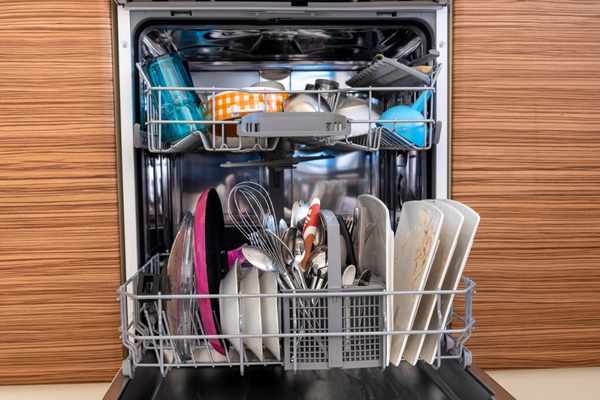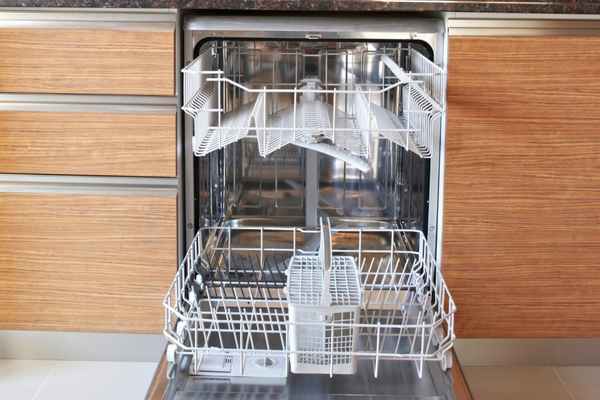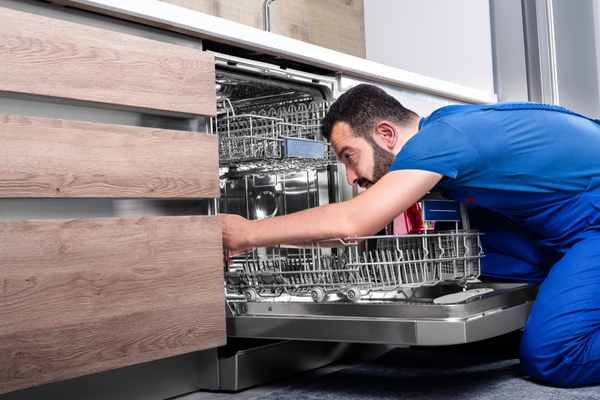Having a broken dishwasher can be quite A nuisance, But luckily it’s not difficult to fix the problem. Replace an old dishwasher or malfunctioning dishwasher is A task almost anyone can accomplish. when the time comes to replace it, The task can seem daunting. Fortunately, replacing an old dishwasher is a relatively easy job that just about anyone can take on with some additional help from this article. We’ll explain what to look for in a new dishwasher, how to install one safely and properly, and provide tips throughout the process. We’ll cover everything from choosing the right model for your needs and budget to properly installing and connecting it to existing plumbing and electrical systems.
What Is A Dishwasher?

A dishwasher is An appliance used to clean dishes, glasses, And other kitchenware. It typically consists of a motorized unit that pumps water through a series of jets and sprayers. The water is heated and mixed with detergent to create suds that help loosen and remove food particles from the dishes. After the cleaning cycle is complete, the water is drained away and the dishes are dried using either hot air or a rinse aid.
Dishwashers are convenient appliances that save time and energy by eliminating the need to hand wash dishes. They can also help reduce water usage compared to hand washing, As they use less water per cycle than manual washing. Additionally, modern dishwashers often come equipped with features such as adjustable racks for different sizes of dishes, built-in sensors to detect soil levels in the wash cycle, and even special cycles for delicate items like wine glasses or china plates.
Why A Dishwasher May Need To Be Replace?

A dishwasher may need to replace if it is too old Or not functioning properly. If A dishwasher is more than 10 years old, It may have parts that are worn out and need to replace. Additionally, if the dishwasher isn’t cleaning dishes properly or is making loud noises, it may need to replace. It could also be leaking water or not draining correctly, which indicates that the dishwasher needs to repair or replace.
Ultimately, The decision of whether or not to replace A dishwasher depends on how old it is and how well it functions. If the dishwasher isn’t working correctly and can’t fix with minor repairs, then replacing it may be the best option. However, If the dishwasher is relatively new and still functioning well, repairing any issues might be A better option than replacing it altogether.
Importance Of Proper Installation
1. Measuring The Existing Space For A New Dishwasher

Measuring the existing space for a new dishwasher is an essential step to ensure proper installation. The measurement process can Be straightforward if you know what to look for and how to do it correctly. First, you need to measure the height of your current dishwasher space. This will help you determine if your new dishwashers will fit properly in the same spot.
Measure the width of your existing space. Dishwashers come in various sizes, so make sure that the one you choose fits well into the available space. Additionally, check whether there are any obstructions that might prevent proper installation like cabinets or countertops above or on either side of where the dishwashers sit.
Measure how deep your current dishwasher is from front to back. This measurement is crucial because it determines how much room you have for a new machine and ensures that all connections reach their corresponding outlets effectively.
2. Choosing The Right Size Dishwasher

Choosing the right size dishwasher can be A daunting task. It’s important to consider the number of people in your household, Your cooking habits, and the available space in your kitchen. A properly installed dishwasher can make life easier by saving time and effort, but choosing the wrong one can lead to frustration and disappointment.
Capacity and dimensions. Dishwasher capacity is typically measured in place settings, which refers to the number of utensils and dishes that can fit inside at once. Dimensions include both height and width it’s important to measure both before making a purchase to ensure it will fit properly in your kitchen.
Proper installation is key to getting the most out of your new dishwashers. This includes ensuring that it’s level so that water flows evenly throughout each wash cycle, as well as connecting it correctly to electricity and plumbing systems.
3. Gathering Necessary Tools And Materials

Gathering the necessary tools and materials before starting your project is key to completing it safely and effectively. Research what tools you will need for the particular project you are undertaking. Make a list of required items such as saws, drills, hammers, screwdrivers, and measuring tapes. Additionally, Make sure that all of your tools Are in good working condition and that you have enough power cords or batteries to complete the job without interruption.
Gather all of your materials according to your project specifications which usually include tiles or planks for flooring or fixtures for plumbing installations. Make sure that you have enough material on hand to finish the job without having to run back out during installation.
4. Shutting Off The Water And Electricity

Shutting off the water and electricity is an essential aspect of proper installation in any home. It is crucial to ensure that all systems are working correctly before moving in or making any significant changes to your property. By shutting off the water and electricity, you can avoid potential hazards and protect your investment.
To properly shut off the water, locate the main shutoff valve, typically located where the water supply enters your home. Turn it clockwise until it stops to shut off all incoming water flow. If you have a separate shutoff valve for each fixture, such as sinks or toilets, make sure those are also turned off. This will prevent damage from leaks while work is being done on these fixtures or during emergencies.
Similarly, turning off the electricity may seem like a no-brainer, but many people overlook this important step when making repairs or installations that require electrical work.
Removing The Old Dishwasher

1. Disconnect The Electrical Cable And Water Line
One of the most important steps in removing an old dishwasher is disconnecting the electrical cable and water line. The first thing you’ll need to do is locate your home’s main electrical panel and turn off power to the dishwasher circuit. You can usually find this panel in a basement or utility room, and each circuit should label so you can easily identify which one powers your dishwashers. Once the power is off, unplug the dishwasher from its electrical outlet under the sink.
Locate where your dishwasher connects to your home’s water supply. Turn off both hot and cold water valves by turning them clockwise until they stop moving.
2. Disconnecting The Drain Hose
Disconnecting the drain hose is an essential step when it comes to removing old dishwashers. To start, make sure that the power supply and water line are turned off as well as disconnected. Then, locate the drain hose which is usually connected to a disposal or sink. Use pliers to loosen the clamp that secures the drain hose in place. Once you have loosened it enough, gently pull out the hose from its connection point. If there is any residual water left in this drainage system, make sure you have a bucket or towel ready to catch any spills.
3. Disconnecting The Power Supply
Disconnecting the power supply is A crucial step when it comes to removing old dishwashers. This task can be dangerous if not done correctly, So it’s important to follow the necessary precautions. Before starting, Make sure that you have turned off the power to your home’s electrical system. You can do this by turning off the circuit breaker or unplugging the dishwasher from its outlet.
Once you have disconnected the power supply, It’s time to move on to removing the old dishwashers from their location. Shut off the water supply by closing the water valve located under your sink or in your basement. Then, disconnect Any remaining hoses or pipes that are attached to your old dishwashers. Make sure to have A bucket ready to catch any excess water that may spill out during this process.
4. Removing The Dishwasher From The Cabinet
Removing an old dishwasher from its cabinet can be a daunting task, Especially if you’re not experienced in DIY projects. However, With the right tools and some basic knowledge, It’s possible to remove An old dishwasher without damaging your kitchen cabinets or causing any other complications.
Turn off the power supply to the dishwashers by unplugging the electrical cord or shutting off the circuit breaker that powers it. Next, disconnect both the water supply and drain lines from under your sink. Use pliers if necessary to loosen any fittings that are too tight. Once you have disconnected all connections between the dishwashers and their water sources, It’s time to remove them from its cabinet. Use a screwdriver to detach any screws securing your old dishwashers in place on top of or underneath your countertop.
Installing The New Dishwasher

1. Placing The New Dishwasher In The Cabinet
Installing a new dishwasher can be a daunting task, especially when it comes to placing it in the cabinet. However, with some basic knowledge and tools, you can easily install your new dishwashers without any professional help.
Here Are Some Tips On How To Place Your New Dishwashers In The Cabinet:
- First and foremost, Ensure that there is enough space for your new dishwashers in the cabinet. Measure the height, Width, and depth of your dishwashers and compare them with the dimensions of your cabinet.
- Make sure that all electrical connections are disconnected before you start installing the new dishwashers.
- Remove any old mounting hardware from inside the cabinet space where you will place your new appliance.
- Check if there are any sharp edges or rough surfaces inside the space where you will place your dishwashers; these could damage its walls.
2. Connecting The Water Supply
One crucial aspect of this installation is connecting the water supply to the appliance. This step is essential for the dishwashers to function correctly and efficiently. You need to check if there is an existing water line connection near the intended location of your dishwashers. If there isn’t one. You will have to create a new connection by tapping into an existing water line or installing a new one. It’s important to ensure that the water pressure isn’t too high or low as this can cause damage or affect the performance of your dishwashers
3. Connecting The Drain Hose
Locate the drain port on the back of your dishwashers and attach one end of the drain hose to it. Be sure to secure it with a clamp or zip tie to prevent any leaks. Find a suitable drain outlet in your home this could be a sink drain or garbage disposal and attach the other end of the hose using another clamp or zip tie. Make sure that there are no kinks in the line and that it’s long enough to reach all necessary components without any tension.
4. Connecting The Power Supply
Make sure that you have All the necessary tools and materials on hand before starting. This may include wire strippers, electrical tape, screws, and a screwdriver. Secondly, ensure that the power supply is turned off at the main circuit breaker before attempting any installation work. Thirdly, locate the electrical junction box under your sink or behind the dishwashers to connect the wiring appropriately.
5. Adjusting The Dishwasher To Ensure It Is Level
Turn off the power supply to your dishwashers by unplugging it or turning off the circuit breaker. Then, remove any items inside and unscrew the mounting brackets from underneath your countertop. Use a bubble level to check if your dishwasher was truly unlevel and place it on top of the door to get an accurate reading. If you find that one side of your dishwasher is higher than another, adjust its legs accordingly by twisting them clockwise or counterclockwise until they’re of equal height.
6. Testing The New Dishwasher
Installing a new dishwasher can be exciting no more washing dishes by hand or struggling with an outdated machine. But once the installation is complete, it’s important to test the dishwashers thoroughly to ensure everything is functioning properly. Here are some tips on how to test your new dishwashers:
Make sure the water supply and electrical connections properly hook up. Turn on the power and water supply, and run a cycle without any dishes inside. This will allow you to listen for any strange noises or leaks that may need addressing.
Load up the dishwashers with dirty dishes and run a full cycle. Check each dish afterward for any remaining food particles or spots that have not been cleaned properly. You can also check for any leaks or unusual sounds during this step. Test out any additional features your new dishwashers may have, such as eco-friendly modes or special wash cycles.
7. Checking For Leaks
Leaks can cause water damage to your kitchen and surrounding areas, and they can also impact how well your dishwashers clean dishes. By following a few simple steps, you can easily check for leaks during the installation process. The first step in checking for leaks is to inspect all of the connection points between your dishwashers and water supply lines. Make sure that all connections are tight and secure, with no visible signs of leakage or dripping. Run a quick test cycle on your dishwashers without any dishes inside to check for any immediate leaks or malfunctions.
8. You Get The Perfect Dishwashers
Once everything is set up and ready to go, using your new dishwashers couldn’t be simpler! Just load up your dirty dishes onto the racks provided. Add some detergent to the dispenser, and turn on the machine. Sit back and relax while your brand-new dishwasher takes care of all your cleaning needs!
The Benefit of Dishwasher Replace

Installing a new dishwasher can be a significant investment for any homeowner. However, the benefits of replacing an old and outdated appliance with a newer model are well worth the cost. Not only will you enjoy enhanced cleaning performance and energy efficiency. But you’ll also save time and effort in maintaining your kitchen’s cleanliness.
One major advantage of installing a new dishwasher improves energy efficiency. Modern dishwashers use less water and electricity than older models, reducing your utility bills while minimizing your carbon footprint. Additionally, many newer dishwashers come equipped with features like delay start or eco-wash cycles. Which further reduces water usage and power consumption without compromising on cleaning effectiveness.
Another benefit of upgrading to a new dishwasher is increased convenience. Today’s models often feature larger capacities that allow for more dishes to clean at once, as well as quieter operations that won’t interrupt your daily routine or disturb sleeping children.
Learn the best methods for removing soap buildup in your dishwasher to keep it running efficiently. Get tips for cleaning and maintenance to keep your dishwasher looking and performing like new.
The Final Thoughts
Replacing a dishwasher is not as difficult as it may seem. By following the steps outlined above, one can easily replace their dishwasher and enjoy the convenience of a new appliance. Additionally, taking the time to measure properly, read up on product information, and acquire all necessary tools before starting will make the process go smoother. Furthermore. If one does run into difficulties during the installation. There are numerous resources available to help answer questions and troubleshoot any issues that arise.
